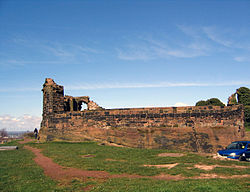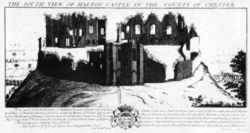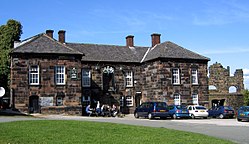Halton Castle, Cheshire
| Halton Castle | |
| Cheshire | |
|---|---|
 Part of Halton Castle ruins | |
| Location | |
| Grid reference: | SJ537821 |
| Location: | 53°19’59"N, 2°41’45"W |
| Village: | Halton |
| History | |
| Built 11th century | |
| Information | |
| Condition: | ruined |
| Owned by: | Duchy of Lancaster |
| Website: | http://www.haltoncastle.org |
Halton Castle stands as an impressive ruin in the village of Halton in Cheshire, beside Runcorn, overlooking the broad, tidal River Mersey. The castle stands on the top of Halton Hill, a sandstone prominence overlooking the village.
The castle is Grade I listed building,[1] and a scheduled ancient monument.[2]
This was the seat of the Barons of Halton from the 11th century until the 14th century and it then passed to the Duchy of Lancaster.[3] It was besieged twice in the Civil War. after which its structure deteriorated. In the 18th century a new courthouse was built on the site of the previous gatehouse. The castle lies in ruins apart from the courthouse which has been converted into a public house.
History
Building and administration
After the Norman conquest, the Barony of Halton was established by Hugh d'Avranches, 1st Earl of Chester ('Hugh Lupus'). The first baron to be appointed was Nigel of Cotentin and it is almost certain that he would have built a motte and bailey castle on the site, constructing it from wood,[4] although the excavations in 1986–87 showed no evidence of a motte and bailey structure or of a timber tower or palisade.[5] It is most probable that during the 12th century the wooden structure was replaced by a castle built from the local sandstone although no documentary evidence of this remains.[5][6] Details of the building works are obscure but it has been suggested that John of Gaunt, the 14th baron, made alterations to the castle[7] but this again has not been confirmed by documentary evidence.[8]
When the 15th baron, Henry Bolingbroke, ascended the throne as King Henry IV, the castle became the property of the Duchy of Lancaster.[3]
The earliest documentary evidence of building work at Halton Castle shows that during the 15th century and into the 16th century it was regularly maintained. Between 1450 and 1457 a new gate tower was built.[8] There is no evidence that the castle featured in the Wars of the Roses; this would have been unlikely because of its relatively obscure position.[9] However a survey of the Royal Palaces in 1609 suggests that by then the castle had fallen into disrepair.[8]
During the Tudor period, Halton Castle was used less as a fortress and more as a prison,[10] an administrative centre, and a court of law.[11] In 1580–81 the castle was designated as a prison for Roman Catholic recusants, but there is no evidence that it was ever actually put to such use.[12]
Royal visits
There is little evidence of any visits by eminent people to the castle, although there is a belief that in 1207 King John visited and donated £5 towards the upkeep of its chapel.[13] Edward II certainly visited the castle and was there for three days in November 1323, during which time he also visited Norton Priory.[13]
Civil War
At the outbreak of the Civil War the castle was garrisoned by the Royalists under the command of Captain Walter Primrose who had been appointed by Earl Rivers. It was besieged by Parliamentary forces under Sir William Brereton in 1643, and the Royalists eventually surrendered after several weeks. On hearing of the approach of superior Royalist forces led by Prince Rupert, the Parliamentarians abandoned the castle and it was held again for the Royalists under Colonel Fenwick. There was a second siege in 1644 but, as the fortunes of the Royalists declined elsewhere, they withdrew from Halton and the Parliamentarians under Sir William Brereton re-occupied the castle.[10]
In 1646 a Council of War was held in Warrington (nearby in Lancashire) where it was decided that the defences of the castles at Halton and Beeston were to be dismantled. In time this was achieved and Halton castle was to have no further military function.[14] By 1650 the castle was said to be "very ruinous".[8]
More recent history

The condition of the building continued to deteriorate although the gatehouse remained in use as a court.[8] In 1728 George Cholmondeley, 2nd Earl of Cholmondeley leased the site from the Crown.[15] In 1737 a courthouse was built on the site of the mediæval gatehouse. Henry Sephton, a Liverpool architect and builder and John Orme, a joiner from Prescot, were appointed to carry out the work.[16] The first floor was the courtroom and prisoners were held in the basement.[17] By 1792 the courthouse had fallen into disrepair and money was found to repair it, although the source of that money is unclear.[18] The court continued to function there until 1908.[19]
Around 1800 three folly walls had been added to the existing ruined walls on the east side of the castle to make it look more impressive from Norton Priory, the home of Sir Richard Brooke. One of these walls was demolished around 1906.
During the Victorian era a sunken garden and two bowling greens were constructed within the castle enclosure.[20] In 1977 the castle was leased to the local council.[21] In 1986–87 the site of the castle was excavated.[22]
Present state

The castle continues to be owned by the Duchy of Lancaster and the site is managed by the Norton Priory Museum Trust. The interior of the castle is occasionally opened to the public and there are plans to make it more accessible in the future.[23] The castle is a Grade I listed building.[1]
The castle walls are in a ruinous state but the circumference is intact and it is possible to walk completely around the exterior. From its prominent position there are extensive views in all directions, including Lancashire, Cheshire, the Pennines, the hills of the Peak District and the mountains of Snowdonia.
The courthouse is now a public house, the Castle Hotel. Its first floor is used as a function room and the basement contains the cellars of the public house. It is designated as a Grade II* listed building.[24]
Outside links
- Halton Castle –Norton Priory Museum, tour information
References
- ↑ 1.0 1.1 National Heritage List 1130460: Halton Castle
- ↑ National Heritage List 1015606: Halton Castle: a ruined shell keep castle on the site of an earlier motte and bailey
- ↑ 3.0 3.1 Starkey 1990, p. 32.
- ↑ Whimperley 1981, p. 3.
- ↑ 5.0 5.1 McNeil 1987, p. 1.
- ↑ Starkey 1990, p. 19.
- ↑ Nickson 1887, p. 146.
- ↑ 8.0 8.1 8.2 8.3 8.4 McNeil 1987, p. 7.
- ↑ Starkey 1990, p. 28.
- ↑ 10.0 10.1 Nickson 1887, p. 148.
- ↑ Starkey 1990, pp. 24–29.
- ↑ McNeil 1987, p. 8.
- ↑ 13.0 13.1 Nickson 1887, p. 145..
- ↑ Starkey 1990, p. 58.
- ↑ Nickson 1887, p. 149.
- ↑ McNeil 1987, p. 9.
- ↑ Starkey 1990, p. 70.
- ↑ McNeil 1987, pp. 9, 11.
- ↑ Whimperley 1981, p. 19.
- ↑ McNeil 1987, pp. 26–27.
- ↑ Whimperley 1981, p. i.
- ↑ McNeil 1987, pp. 21–28.
- ↑ Halton Castle - The Norton Priory Museum Trust
- ↑ National Heritage List 1115543: The Castle Hotel Public House
- McNeil, Robina (ed.) (1987), Halton Castle: A Visual Treasure, Halton Castle: A Visual Treasure: North West Archaeological Trust
- Nickson, Charles (1887), History of Runcorn, London: Mackie & Co.
- Starkey, H. F (1990), Old Runcorn, Halton Borough Council
- Whimperley, Arthur (1981), Halton Castle: An Introduction & Visitors' Handbook, Widnes: Arthur Whimperley
Further reading
- Nikolaus Pevsner: The Buildings of England: Cheshire, 1971; 2011 Penguin Books ISBN 978-0-300-09588-3